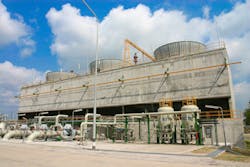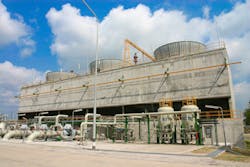Corrosion Control
Protection For Cooling And Wastewater Systems
CorrBlock is time-release, biodegradable corrosion inhibitor block for water treatment industries as well as being friendly to marine ecosystems. The apply block is formulated using soybean-based wax and proven Vapor phase Corrosion Inhibitor technology.
When immersed in water it slowly dissolves and releases calculated amount of inhibitors required for corrosion protection of a system. The inhibitors in CorrBlock are designed to provide multimetal protection and can be used as replacement for chromates, nitrites, and other types of restricted corrosion inhibitors.
VpCIs form a strong monomolecular layer on metal surfaces that protect in all three phases - liquid, vapor, and the vapor-liquid interface.
According to the manufacturer, CorrBlock eliminates the need for dosing pumps and tanks for conventional liquid inhibitors as well as protects tools, workpiece, and metalworking machines during downtime. www.cortecvci.com
Chelating Agents To Prevent Scale Accumulation
Chemicals company Rivertop Renewables has launched the Waterline corrosion inhibitors and chelating agents, a family of chemicals designed to be integrated with products in the water treatment industry. The sugar acid technology platform offer a range of versatile organic corrosion and scale inhibitors. Waterline SI chelating agents are designed to help control and prevent hard water scale accumulation, while Waterline CI corrosion inhibitors offer formulation flexibility. The company said: “By formulating Waterline corrosion inhibitor and chelation chemistries into water treatment products, cooling and process water professionals can better maintain infrastructure and improve the overall performance of facilities - with sustainable ingredients made from renewable sources.” www.rivertop.com
Corrosion Proof Double Chamber Valves
Dorot Control Valves has launched the new Back Flushing Valve (Model 51P and 52P), a valve designed for industrial market for use in automatic backwashing of filtration system. The Back Flushing Valve has a plastic body made from corrosion-proof material and has chemical and cavitation resistant (additional versions for sea-water and aggressive media available). The valve is a double-chambered that provides control of fluid movement and protection of the diaphragm. It is a 3-directional valve in a “T” configuration that allows straight or angle flow with easy conversion from one model to the other, offering maximum flexibility to system design. www.dorot.com
Avoiding Cooling Water Fouling
With a mere 0.005 inches of microbiological fouling in a 1,000 tonne cooler able to increase annual electricity costs by £30,000, Chem-Aqua said its water treatment solution for cooling systems can reduce energy, water, and maintenance costs while ensuring safe and reliable operation.
Available in liquids, solid pastes, tablets, powders and granules, Chem-Aqua oxidative solutions are delivered in appropriate measures to ensure complete dispersion throughout a system and levels are continually monitored.
Bespoke treatment can increase the life of a water cooling system, not to mention the whole plant, and reduce operating costs. Chem-Aqua said its survey engineers test samples from every cooling system the company treats to determine the exact nature and optimum measure of biocides for each system. Precisely establishing the threats, by determining pH levels, half life, and organic loading on the system, means Chem-Aqua can tailor the treatment to target specific problems. The company referenced the steel industry, in which water is used to cool molten steel, and it is common for slag and oil to contaminate the water coolant. In this situation, typical oxidising biocides, such as sodium hypochlorite (chlorine), may be ineffective and chlorine dioxide could be more suitable. Testing done during the survey process would highlight this before treatment began. http://chemaqua.com/
More Water & WasteWater International Archives Issue Articles



